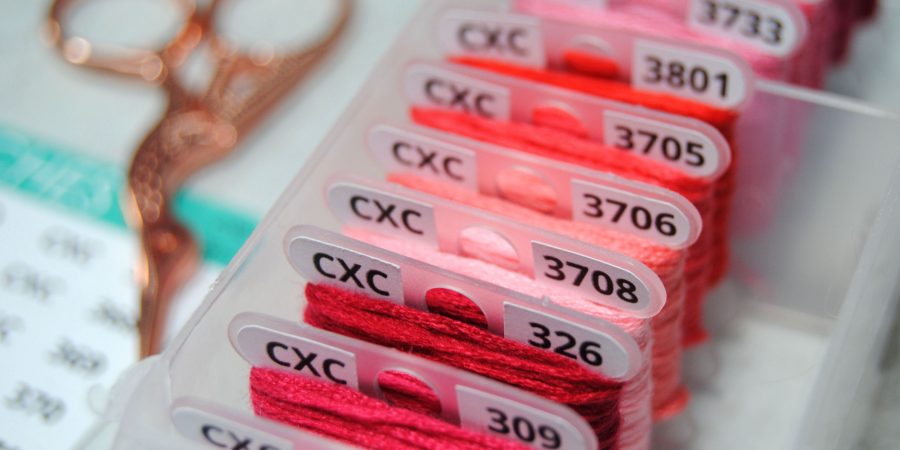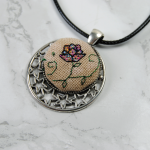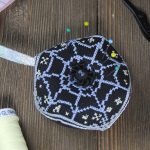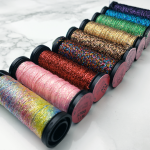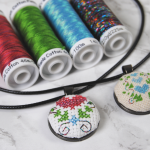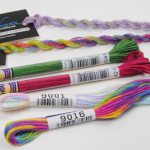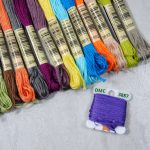Some of you find this article because you simply want to know if CXC floss is good enough to stitch with. But others may stumble across this never having heard of CXC brand floss and are wondering what I’m even talking about. Which is fair as it’s still not readily available in most cross stitch supply shops. So let me explain why I’m even writing this.
Table of Contents
What is CXC?
Long story short, CXC is a brand of embroidery thread manufactured in China. It uses the same numbering scheme as DMC, making it really easy to substitute colors rather than having to find a conversion chart online like you would with Anchor, Cosmo, or other popular brands.
I was not able to find any information as to what CXC might stand for. Then again I don’t think most people know what DMC stands for either, so that’s fine. (Dollfus-Mieg et Compagnie)
Where to get CXC
At the time of writing this, the best place to get this thread is AliExpress. However, if you’ve never used AliExpress it can be quite daunting. Unfortunately I can’t directly link to a “good” listing, as things seem to constantly change on this site. It’s similar to Amazon in a way, as you’ll see tons of listing of the same exact item at different prices with different shipping rates and no matter how many good reviews you will always find a handful in every listing that claim the item set their house on fire or something.
Speaking of Amazon, there ARE listings on Amazon for CXC floss but it tends to vary wildly from being horribly overpriced, to very clearly not CXC based on the photos alone. So be careful if you decide to go that route.
You’ll also find listings on Etsy for CXC brand thread. These are more than likely people who have purchased in bulk via AliExpress and are reselling on Etsy, but if you don’t want shipping to take a month+ or you simply want someone else to essentially pick out an AliExpress listing for you, this is absolutely a valid option. They’ll be a little bit more expensive, but could be worth the time and effort for you. You can also reach out to them in advance to confirm they are in fact CXC. Keep an eye on reviews and ask around to see if anyone in your stitchy communities has purchased from them before.
Searching on AliExpress
Searching for “CXC floss” on AliExpress does pull up 60 pages of results. Some of which is dental floss. So… let’s try to narrow that down.
If you’re looking for a full set, you’ll probably want to include “447” in your search, as that’s the full set CXC offers at this time. We’ll talk about what’s ‘missing’ from that further below.
You might also want to include “two labels” in your search, as those are the newer versions of the thread. That should get you down under 10 pages at least.
You’ll then want to send some time comparing prices (keep an eye on that shipping!) and looking through reviews, how many units they’ve sold, etc… And apparently also messaging sellers to confirm they are indeed CXC.
In the end I ended up picking a listing that didn’t have a ton of reviews, but the store had a lot of positive reviews overall, and had been open at least 2 years. They also carried some other things I wanted, so I could get them all at the same place. It took over a month to arrive, but the entire set was under $40 including shipping.
Barcode Bluff
From what I could find online and thanks to one of my Patrons… you’ll want to confirm with the seller and even request “proof” of what brand thread you’re getting before purchasing.
For CXC you’re apparently looking for barcodes that end in 14. There are other brands and numbers out there, but I couldn’t find a list of which barcodes go to which brands.
How do each of these brands differ from each other? No idea. But the general consensus online is that 14, aka CXC, are the best. Though others say the varying barcodes are not a good way to determine quality anymore. So you mileage may vary. And things may change again in the future. Who knows.
However, if we’re following the barcode theory, the set I got don’t all end in 14 but rather a mix of barcodes. However, texture and quality were fairly even across the board despite that. What seems to be different is the dye lots and color accuracy. The ones I got that end in 21 for example tend to be the furthest away from the DMC colors I compared them to. While those ending in 14 tended to be pretty close to the original. But we’ll talk color comparison later on.
As getting a mix of threads is likely to be most people’s experience, I’ll continue with my testing with what I received. Focusing primarily on those whose barcode ends in 14 and are “true” CXC.
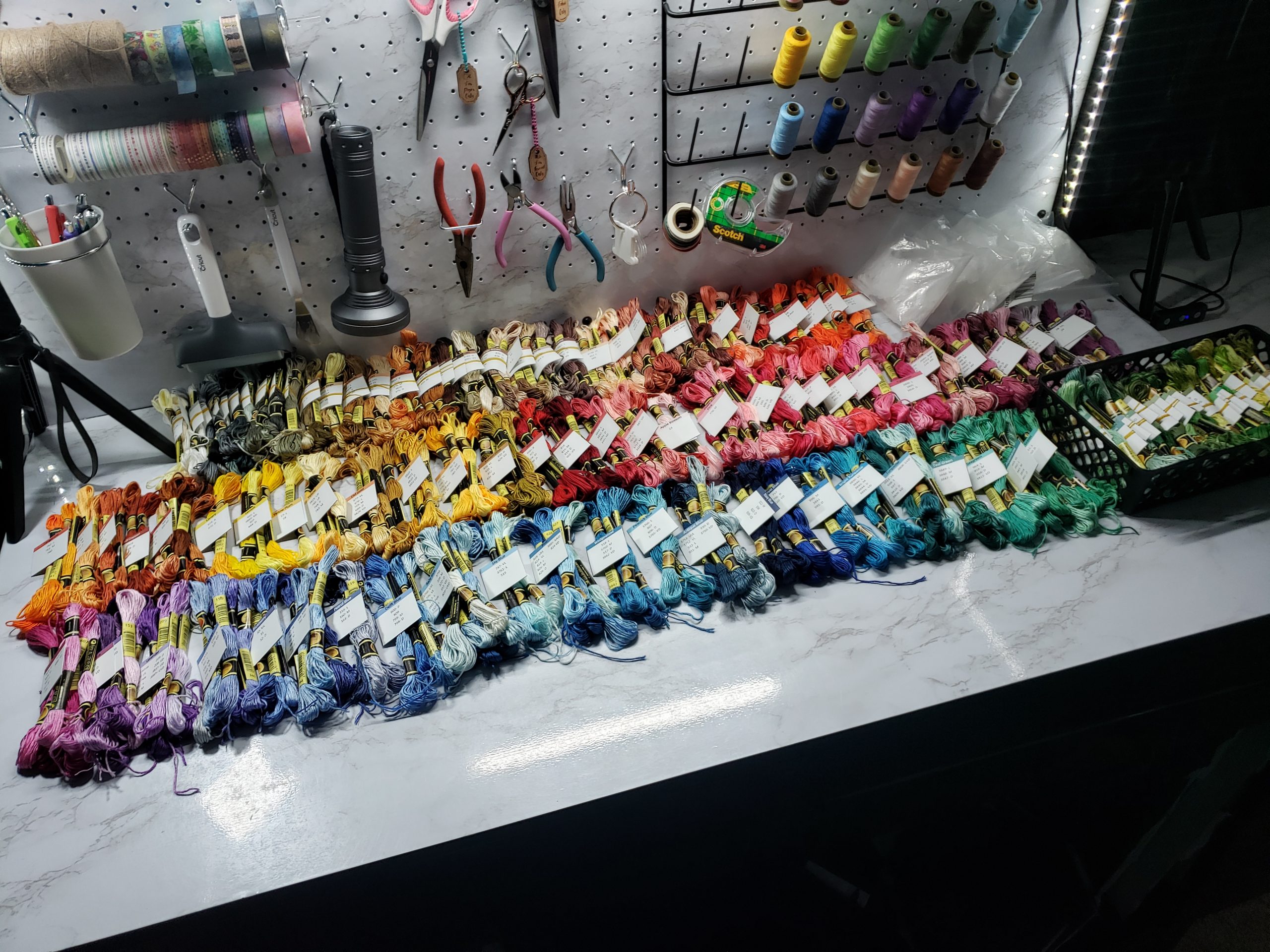
DMC vs CXC Floss
Okay, so what IS the difference? How do these Chinese threads compare to the standard DMC most embroidery artists and cross stitchers alike tend to use in their projects?
Difference in thread composition
The most obvious difference right off the bat is that DMC is 100% Cotton. Meanwhile, CXC threads are listed as Cotton / Polyester blends. I could not find a percentage to show how much polyester is blended in, but it’s certainly enough to make a texture difference.
In person you can tell that the CXC threads are softer. And smoother. They also have a bit more of a shine to them. It’s subtle, but it’s there. If you’re the kind of person that has sensitivity to textures, the fact that it’s different at all may be enough to put you off from stitching with these. It’s not a bad texture by any means, but it is different.
Price Difference
Price is gonna be the main reason people consider picking up CXC thread. But prices are constantly changing, so I can only give you prices from when I’m writing this in June 2022. Depending on when you’re reading this, they may no longer be accurate.
At the time of writing, DMC skeins are $0.99 USD on DMC.com, $0.62 USD at Michaels, and $0.60 USD at 123Stitch.
Price for CXC on AliExpress varies, but seems to average out to around $35 USD (not including shipping) for a full set of 447 skeins. This makes them around $0.08 a skein.
Some AliExpress listings let you choose colors as well, but tend to sell in bundles of 10 for $1, or 40 for $4, etc. Closer to the $0.10 a skein.
On Etsy, a full set of CXC floss seems to be closer to $60 USD (again without shipping). Closer to $0.13 a skein. If you buy individual skeins off Etsy in order to get specific colors, currently they’re listed for $0.33 a skein. However, you’re also more likely to get good quality CXC and sellers are more willing to prove this to you prior to purchasing.
Either way, this is a far cry from the $0.62 a skein for DMC. So if you’re buying thread for a big full coverage piece, or just want a full collection… CXC is definitely much more budget friendly.
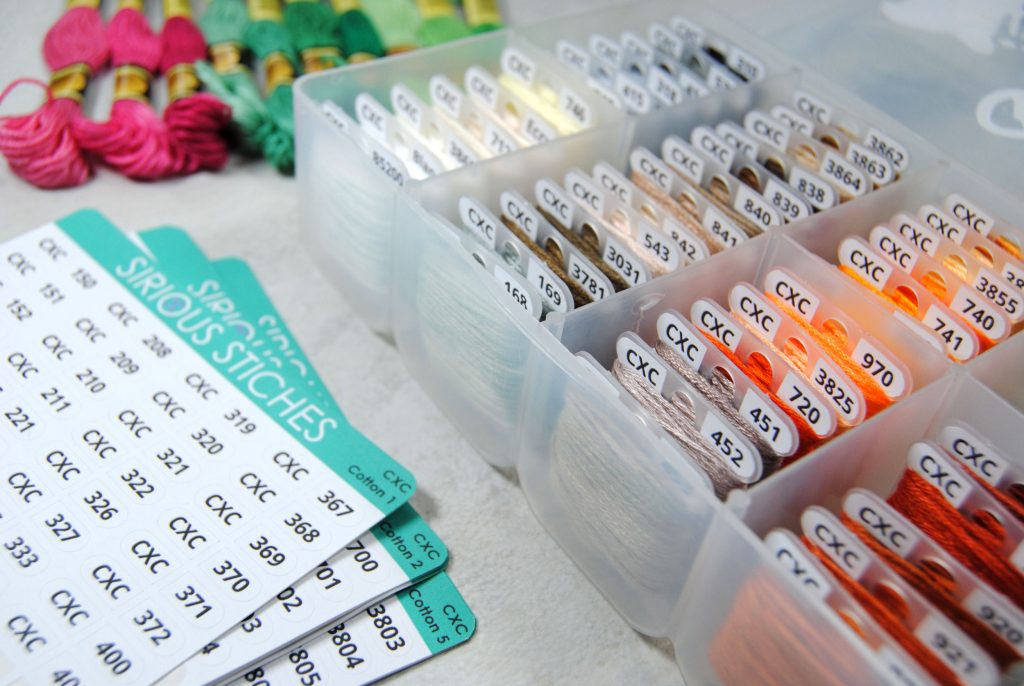
Missing colors
I keep saying that magic number of 447. But there’s 505 DMC colors! So what’s missing?
The discontinued DMC colors 504, 731, 776, 781, 971, 806, and 868 are not included in CXC’s lineup. Likely because there are other colors similar enough to these that it’s not needed.
The 35 new colors released in 2019, 01-35 are also not included in the CXC lineup. However, there seems to be some other off brands that do offer these if needed. I haven’t tested them out personally, but “Rose” threads seems to be mentioned online as the closest to CXC that offers these colors.
The colors 3880-3895 released in 2013. This isn’t that surprising, as even DMC only ever offered them in a pack. And then only in the US before discontinuing them. Some shops still have some in stock, and others have even split them up into singles. But they’re still pretty hard to find.
What’s it like to stitch with
Other than the texture difference mentioned previously, it’s quite similar to DMC in terms of stitching. I will note that they feel a bit thicker as well, which we’ll discuss in the coverage section. Not quite as thick as stitching with Sulky Petites where you only need one strand. But thicker than DMC. I ended up swapping up to a larger eye needle because it was slightly harder to thread.
The only other thing I noticed while stitching with them is that twice while stitching I came across a section of thread that was very frayed. Just one strand would be fluffier than the others, but only for a short bit.
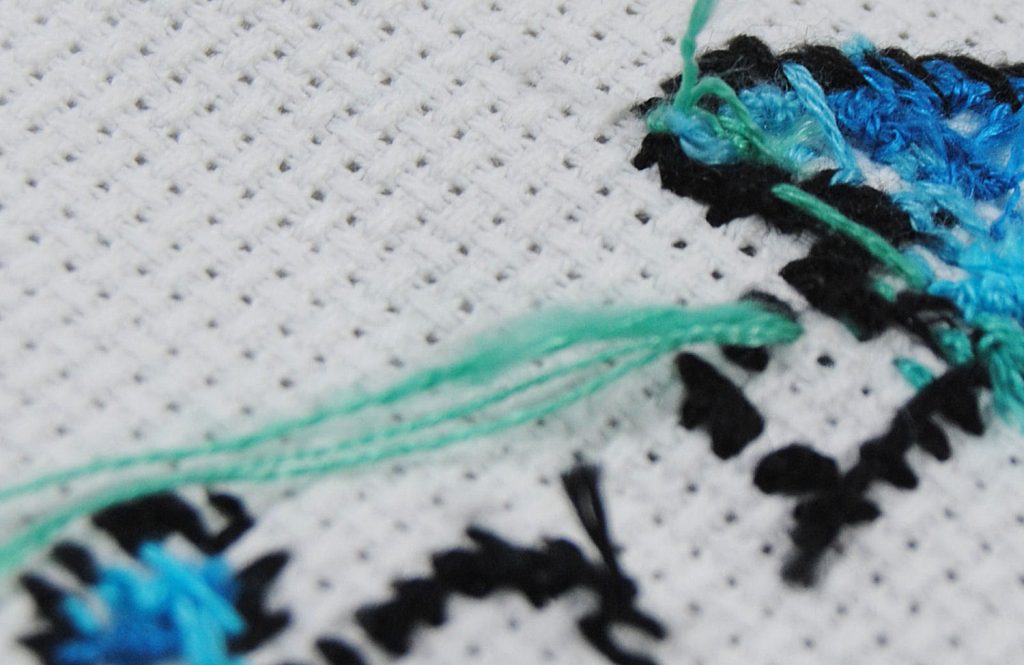
The other time this came up was even smaller so I didn’t even try to take a photo of it. And both times it was one of the ones with a barcode ending in 21.
Considering how cheap the thread was, I’m not too fussed with losing an inch of a single strand of thread, but having to rethread or work around this can be annoying.
It doesn’t seem to come up very frequently at least, but something to look out for when prepping your thread.
CXC Floss Color Accuracy
Now the part many of you are very curious about. How close is CXC to DMC threads? Well I’m not going to compare all 447 threads for you or I’d be taking photos for the next month and I wanted to move on to getting them on bobbins. However, I did take several shots of random selections of colors that I happened to have DMC skeins of on hand to compare them to.
Single label
As mentioned previously, CXC used to be single-label. I happened to have a few of these on hand to compare, but not many. The few I had are pretty spot on to the DMC colors, though! There are subtle differences in shininess and hue. But no more than I would attribute to dye lot or age differences between two DMC skeins.
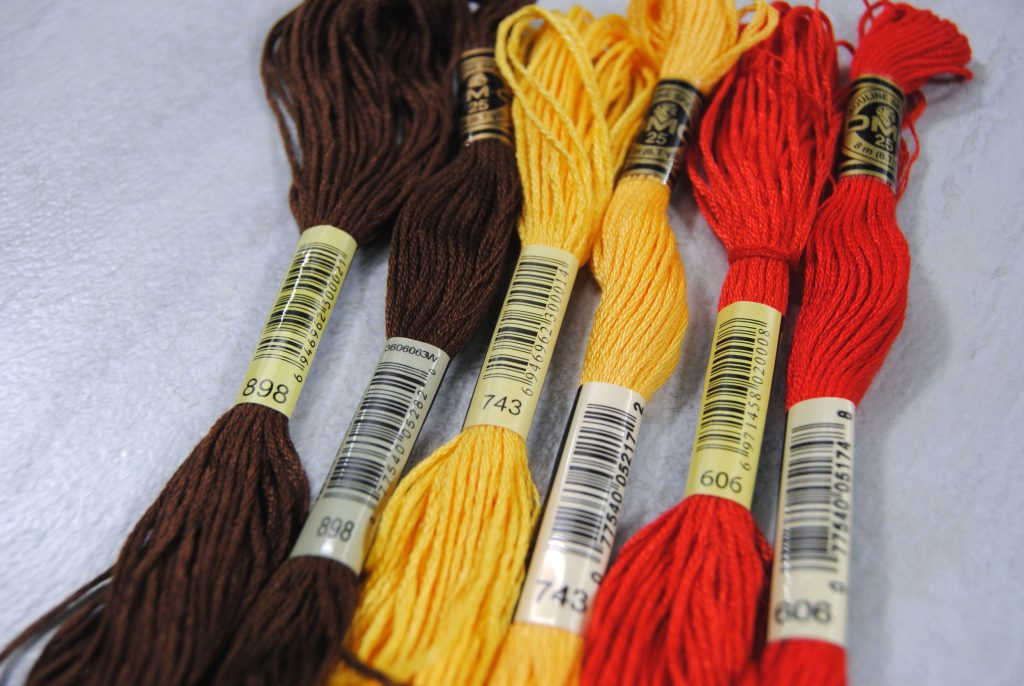
Double label
Since I had a whole set of two label floss I was able to do a lot more comparisons. There are definitely some colors that are a little more than just a “dye lot difference”. But arguably still reads as the color it was attempting to be. The 912 here stands out quite a bit to me.
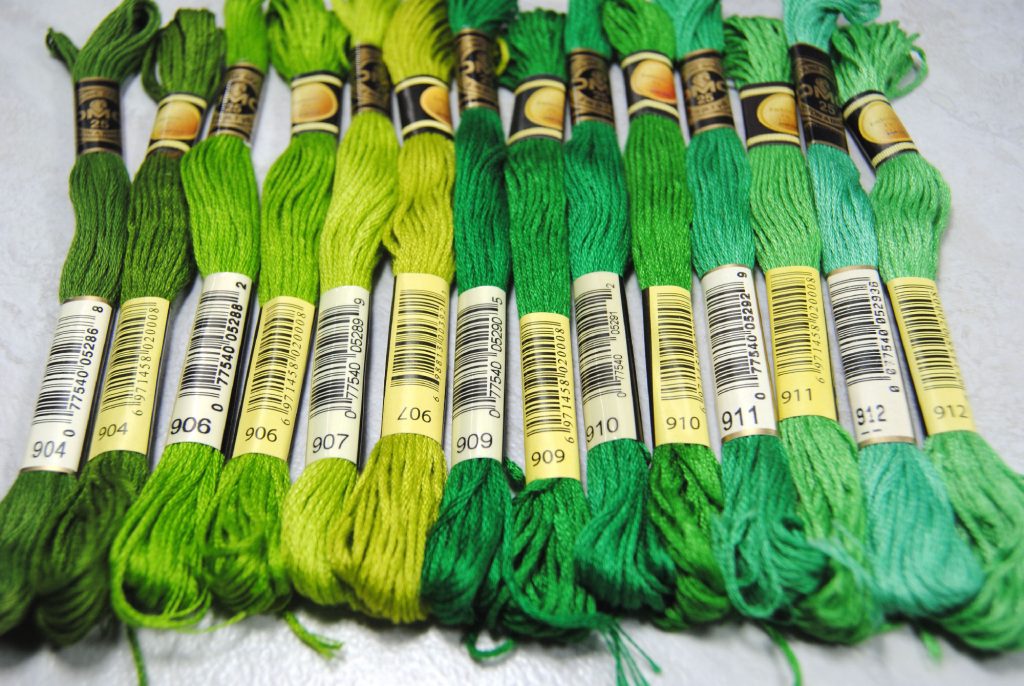
To be fair, not all of the DMC skeins I have are the newest possible either, as you can see by the label differences. But that can only account for so much.
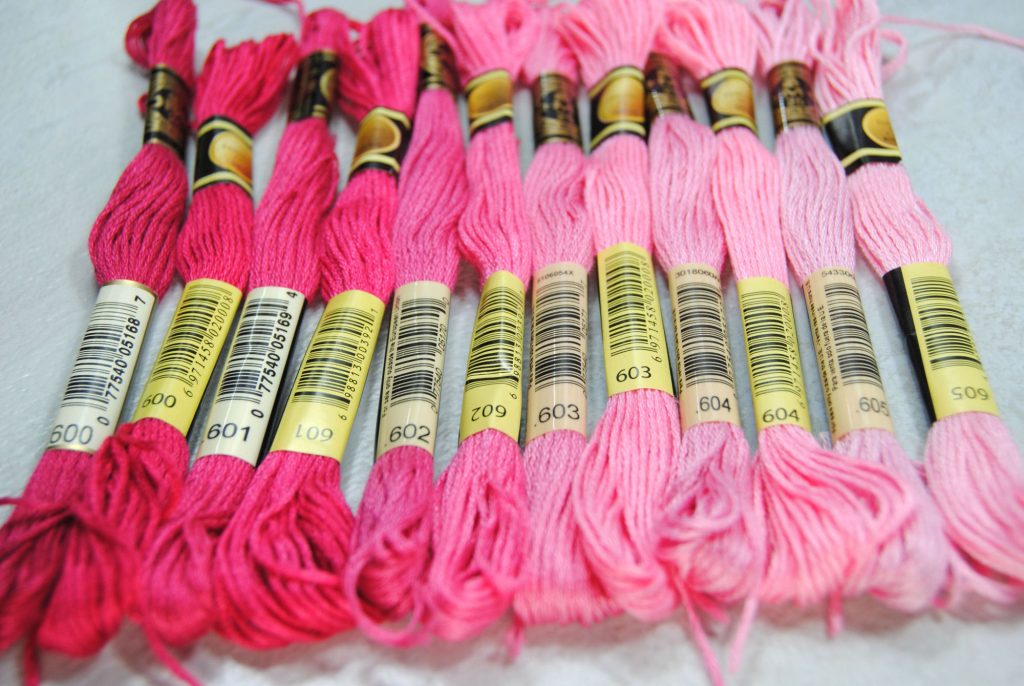
The pinks and reds were all really close from what I could see. The differences in colors were more apparent when it came to blues and purples. And even then mostly in the ones whose barcodes ended in 21.
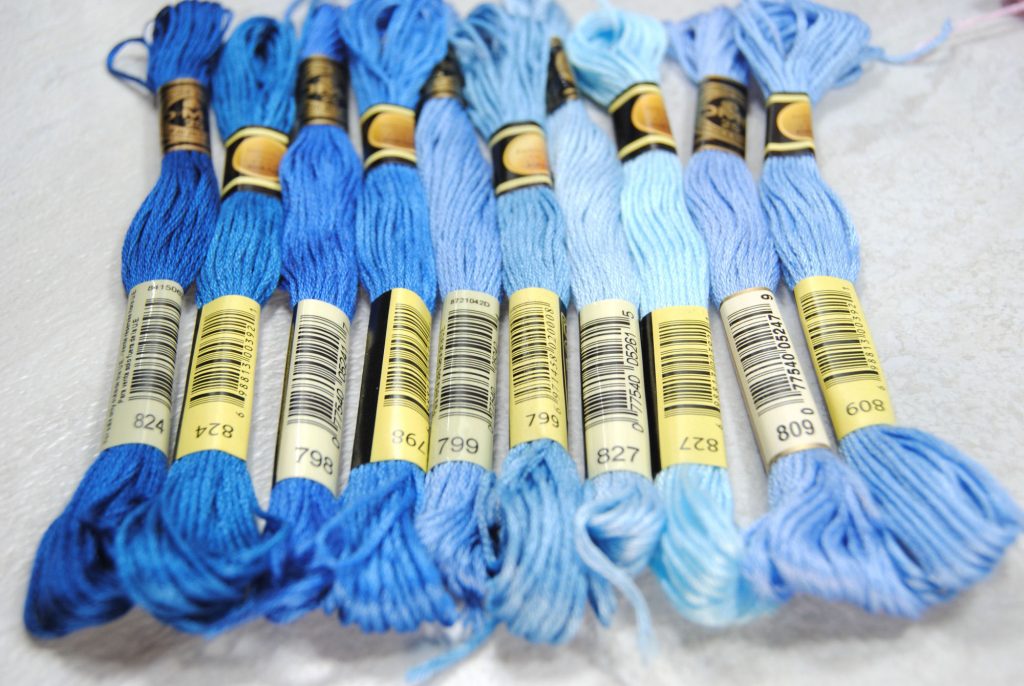
That 827 for example is VERY different. A much lighter tone. But it would still likely work fine in a pattern that called for it on its own, rather than as part of a gradient.
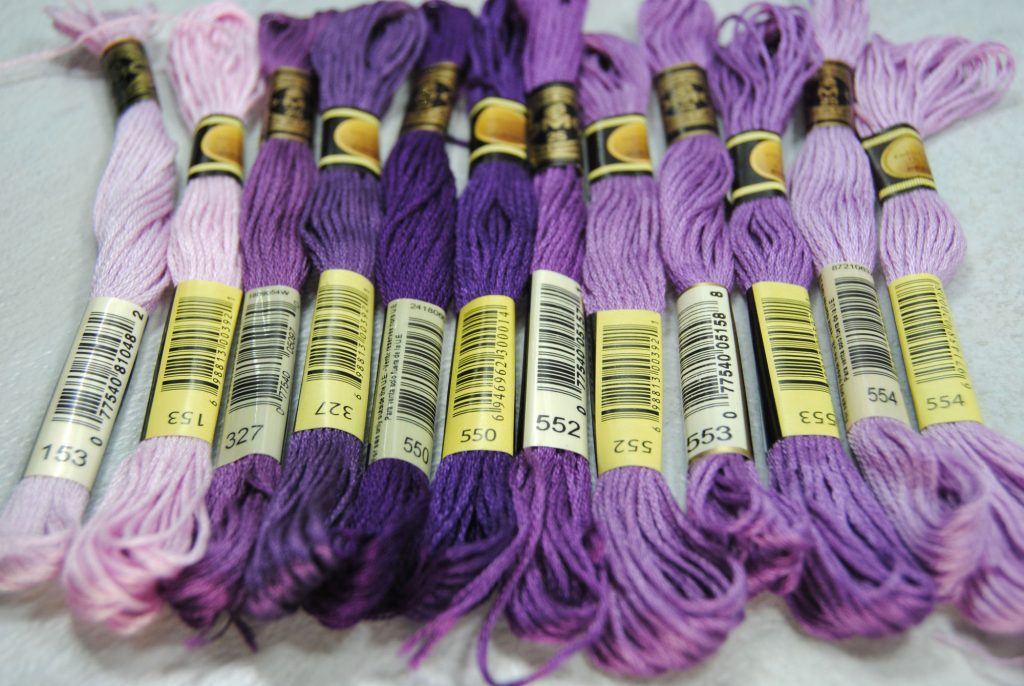
Purples being a little different isn’t too surprising. They’re notoriously hard to color match. Even then, 327 and 552 are the only one that really stands out as being different from the DMC equivalent. Again being barcodes ending in 21. Seeing a trend, there.
Then again, as long as you’re not stitching with two different skeins in a single project it shouldn’t be noticeable. Considering I’ve seen these kinds differences between aged DMC skeins as well…
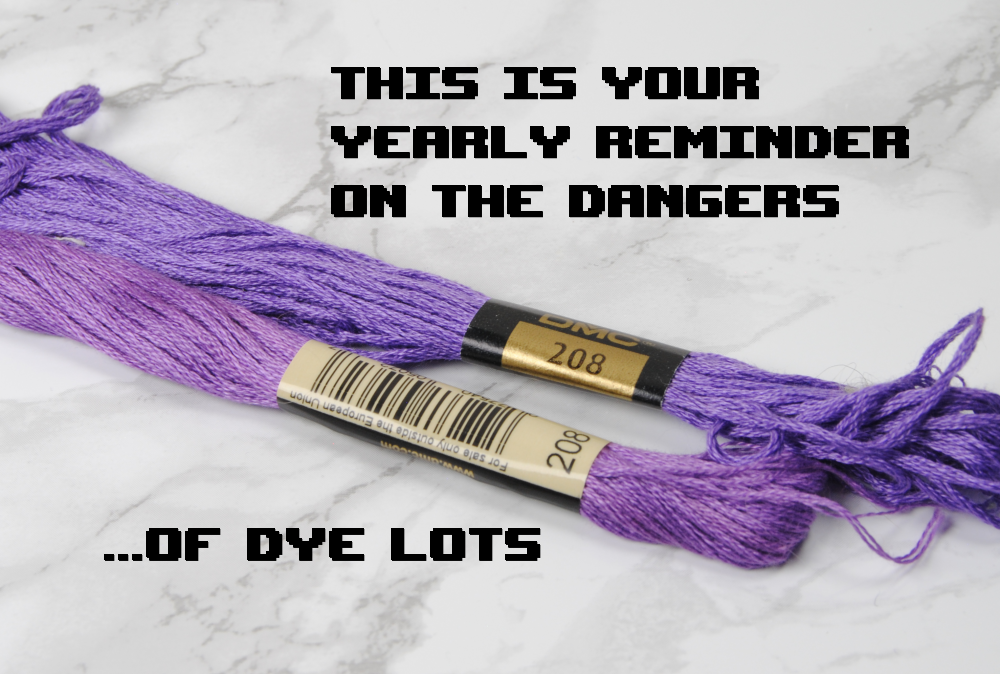
Though as you can clearly tell from the label, one of these DMC skeins is much older than the other. You won’t find this stark a difference between skeins in store typically.
Coverage Test
Next up! Coverage. For this test I am using 14 count white aida and 310. Because 310 already gets picked on for not having enough coverage. But also just for maximum contrast to make it easy to compare.
Surprisingly… CXC floss wins this round! You can see it right off the bat at stitching with a single strand. But it’s especially nice at 2 strands, which is what I normally stitch with.
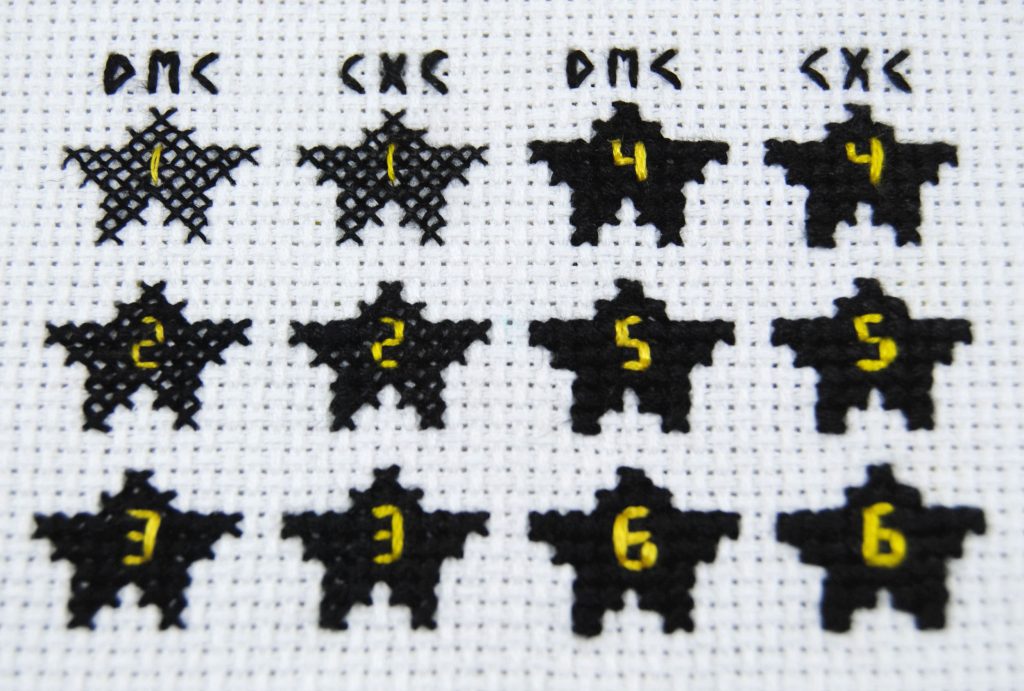
3 and beyond I honestly can’t tell the difference from the photos. It’s definitely puffier in person though, because there’s that extra bulk. But it’s not necessary to use that many strands for stitching, and much harder to get your thread through the holes.
You ever see beginners accidentally use all 6 strands and be confused as to why it’s so difficult? Have you ever tried it yourself? It’s not fun. I don’t recommend anything above 3 strands even on 14 count fabric. If you’re stitching on like, 8 count plastic canvas or something it may be worth a try though!
Regardless of what you’re stitching on, doing a sample like this is something I generally recommend so you can determine what YOUR preference is that balances both coverage and ease of stitching.
Color Fastness
The next thing I want to test is whether or not CXC floss is colorfast. I picked a color that I had in all 3 versions, 606. DMC, CXC single label, and CXC two label. I also picked red because it is NOTORIOUS for being the most likely to bleed.
I stitched these with two strands and submerged it in hotter water than I would normally wash with. Not hot enough that it would burn to touch. But warmer than I would normally use to take a bath myself. I always recommend washing your cross stitch with cool or lukewarm water just in case. However since this is a test, I wanted to go all out.
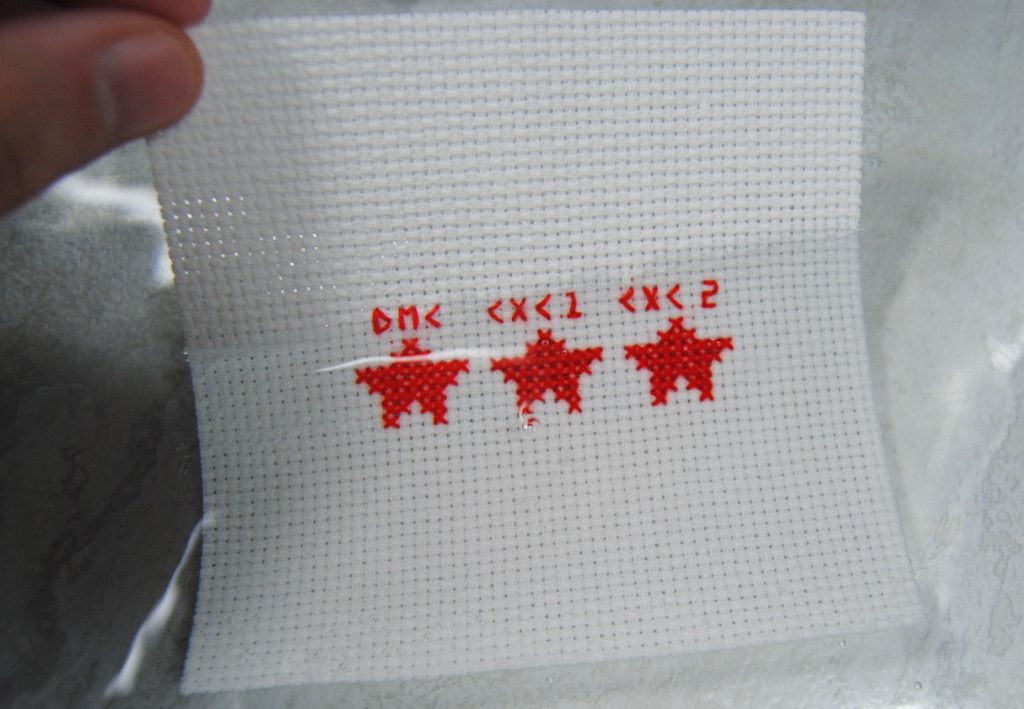
Not only did I submerge it and let it soak for a bit, but I also rubbed at the thread with my finger and folded it over a bit to rub the thread against some of the plain white fabric.
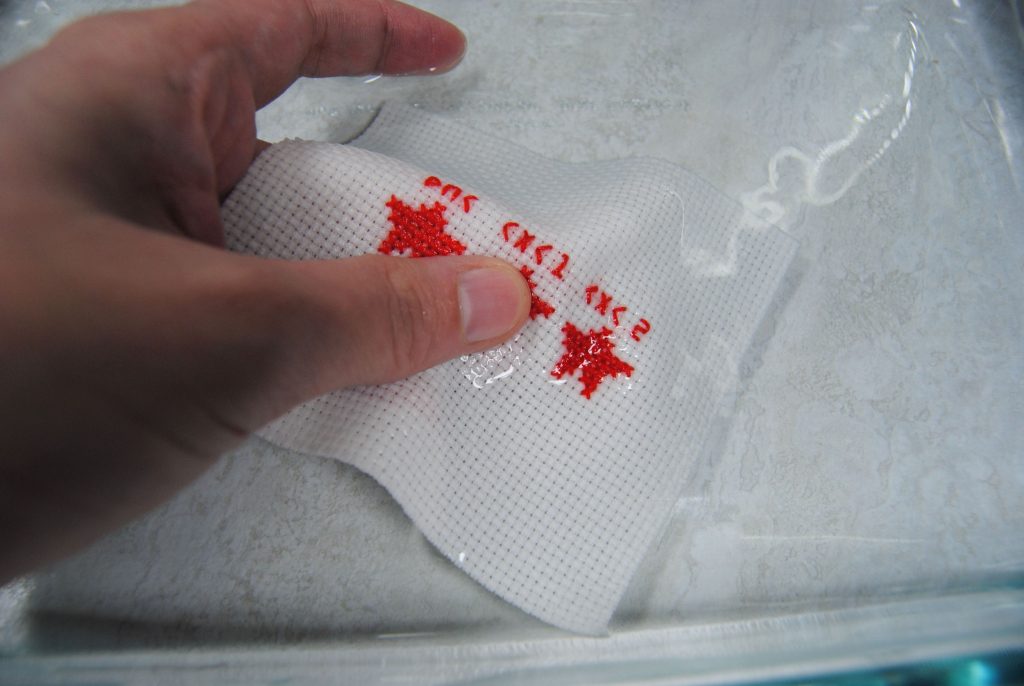
I even got some fresh hot water and re-dipped it to be 100% sure. And yet, no signs of bleeding on any of them. Just the hint of the thread from the back of the project as being wet makes that white aida semi transparent.
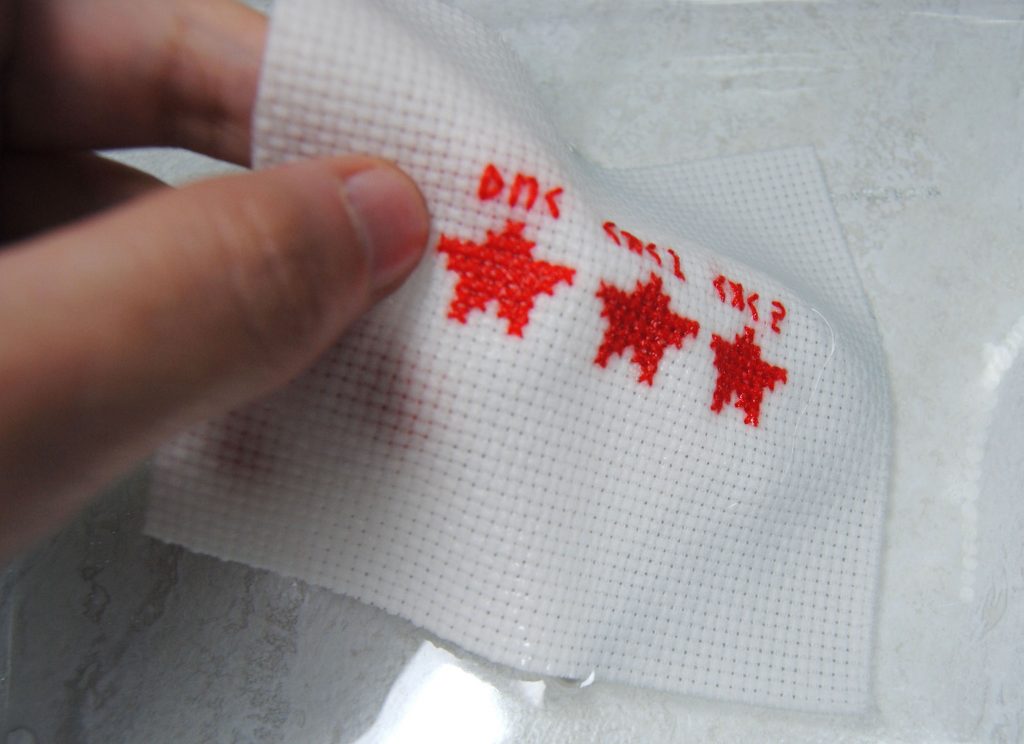
Ironing / Heat exposure test
So how to push this test just a bit further? Iron it on medium just seconds after pulling it out of the water. Yep. Another thing I don’t normally recommend because it can cause bleeding. Heck my ironing board cover still has a red stain on it from a DMC variegated thread test that I ironed while still wet and it bled everywhere.
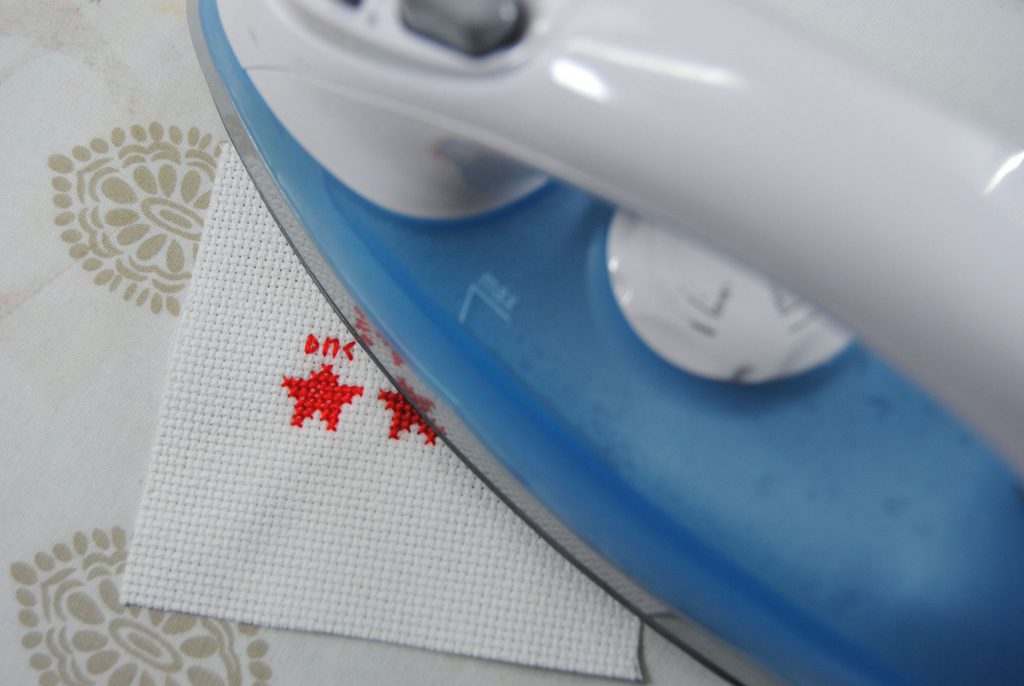
And yet… nothing. Dried like it was freshly stitched. Not bad at all. You can just barely see where I trailed threads along the back, but no bleeding.
Despite me ironing straight on the thread and not using a cloth between the two there was no melting, either. Which can be a concern for plasticky threads, like the Sulky Glowy thread that completely melted on me a while ago.
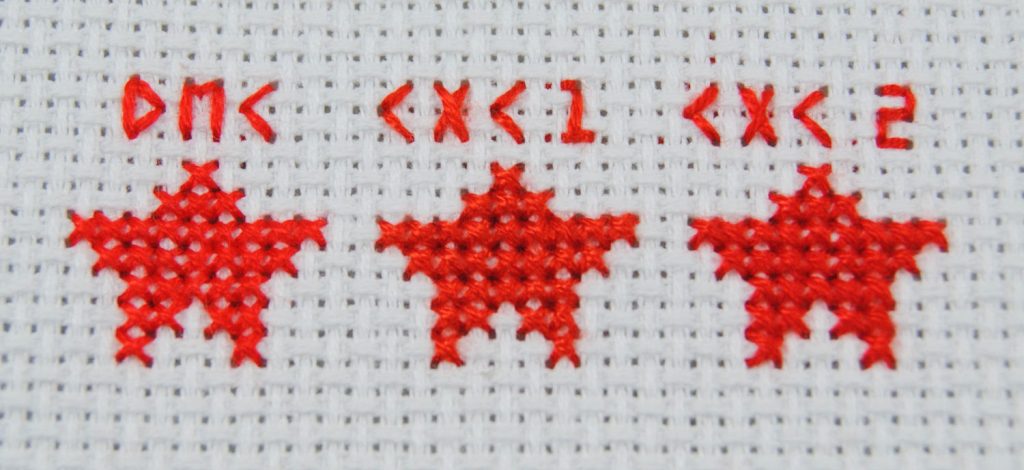
Light Exposure Test
The last test for this thread you’re gonna have to come back to see the results. I set that test swatch in the sunniest spot in my sun room on June 5th, 2022. Now, I work third shift so I rarely see the sun. But the idea is to leave it in a sunny spot and see how long it takes to notice a difference in color.
In this picture it’s been out there for literal minutes and it already has dog hair on it somehow. Not part of the test, but well that’s a thing I guess.
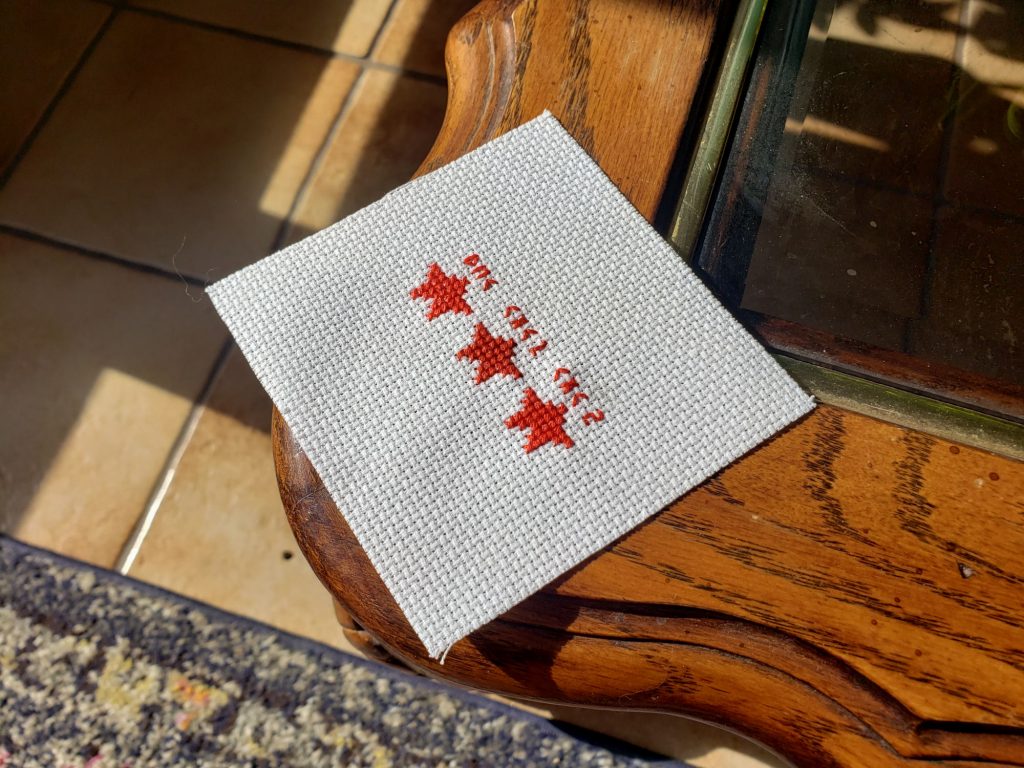
I’ll update this post every once in a while to let you know how that progresses.
Almost a year later (May 2023), this is what those swatches that have been living in my sun room compared to a second set of swatches I had stitched on the same day back in June 2022
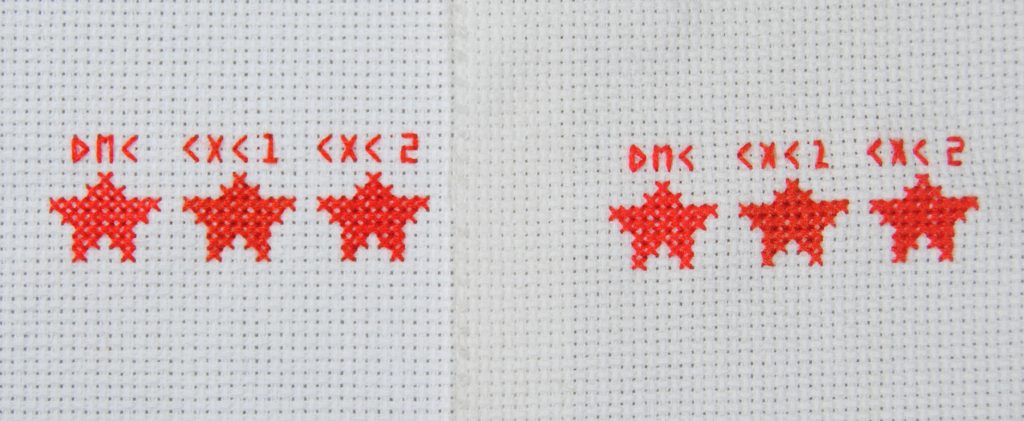
The one on the right is the one that was in the sunroom. While my control stitch stayed safely tucked away in a drawer in my basement office all year.
Interestingly, the aida has been affected more than the thread itself. Taking on a slightly yellowish tone. But the red thread is as vibrant as ever so far. We’ll see how it looks in another year or so.
CXC Floss Stitch Comparison
Okay, one last test. Let’s stitch something other than just swatches. I decided to do my free DDR arrows pattern, as I didn’t have time to design something new. Plus, this pattern has several color changes and uses blues and purples which had the most noticeable color differences.
First, let’s compare the color palette on bobbins. The main difference right now is that I actually USE my DMC threads (green labels) quite a lot, so those bobbins are noticeably thinner than the freshly bobbined CXC floss (white labels).
That aside, there are definitely some noticeable differences in color as well, especially in the bright blues.
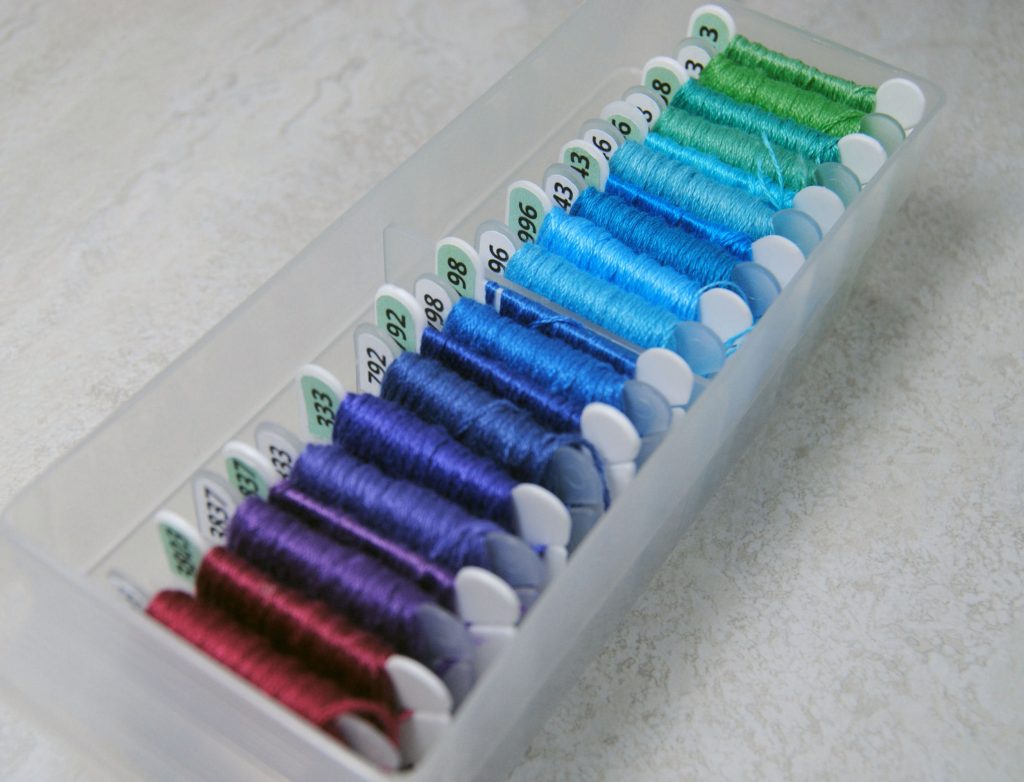
Mixing thread brands
But how noticeable is it when stitched? First up I mixed DMC and CXC in the same design to make it easier to see the differences. I’m using 3 strands on all of these tests since the difference in coverage on 2 strands makes it too easy to tell them apart and I wanted to give you a fair chance to compare.
Before you read on to find one what’s what, can you tell which of these colors was stitched in CXC?
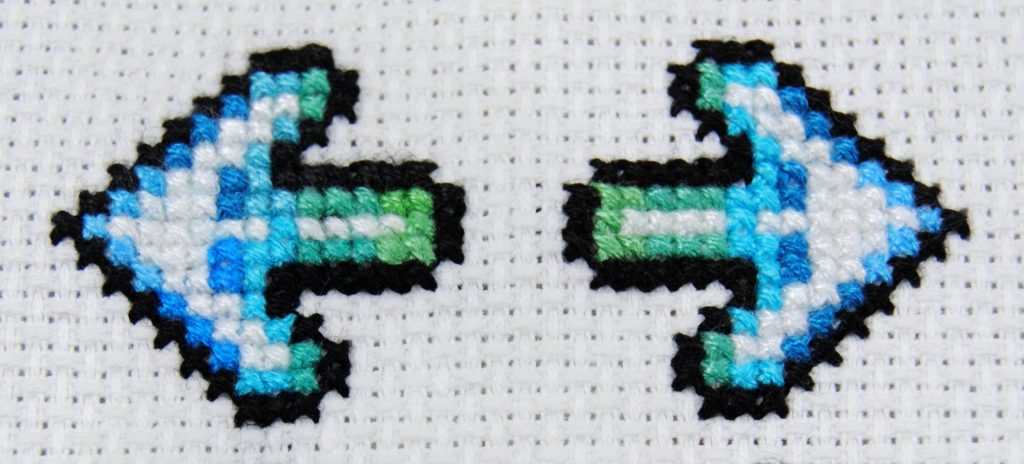
Ready for the answers? The arrow pointing left is divided in half. The top half is entirely CXC. The bottom is DMC. If you look at just one half or the other it’s hard to really tell. But seeing the colors side by side you can see the subtle differences in color.
The arrow pointing right is also half CXC half DMC. But I just alternated which colors were which. So, all the black is DMC, but all the white is CXC. The lighter blues and lighter green are DMC, and the darker blue and darker green is CXC. Much harder to tell that they’re not the same brand, right?
Side by side comparison
Now let’s do the entire design in one brand. One of these is entirely in CXC, one entirely in DMC. I’m gonna tell you. But before you scroll down, can you guess?
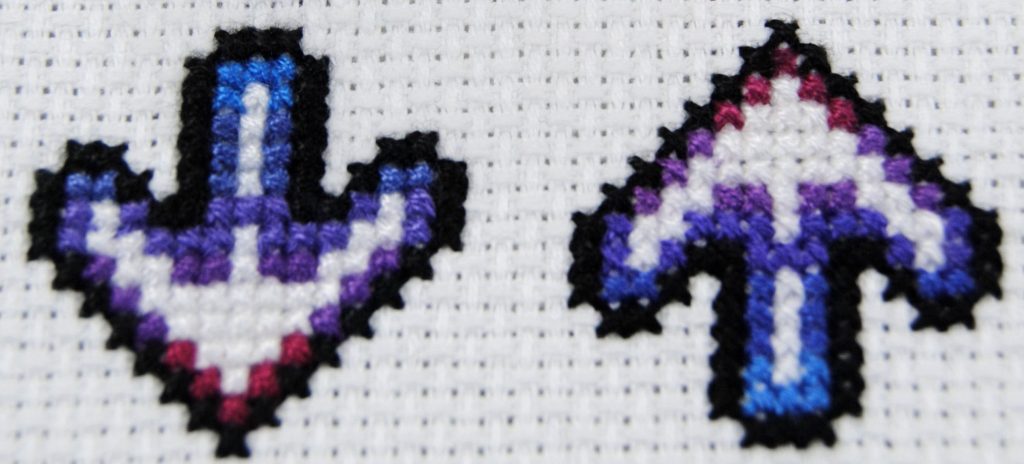
Picked out which is which? The one on the left is entirely CXC floss. You can still kinda tell by the better coverage, despite using 3 strands to try and hide that. Oh well. The DMC one on the other hand seems more… vibrant somehow? Brighter? I’m not sure how to describe it.
Taking clear photos of these differences was very difficult, so I’m also including a 600dpi scan of my finished stitches as well.
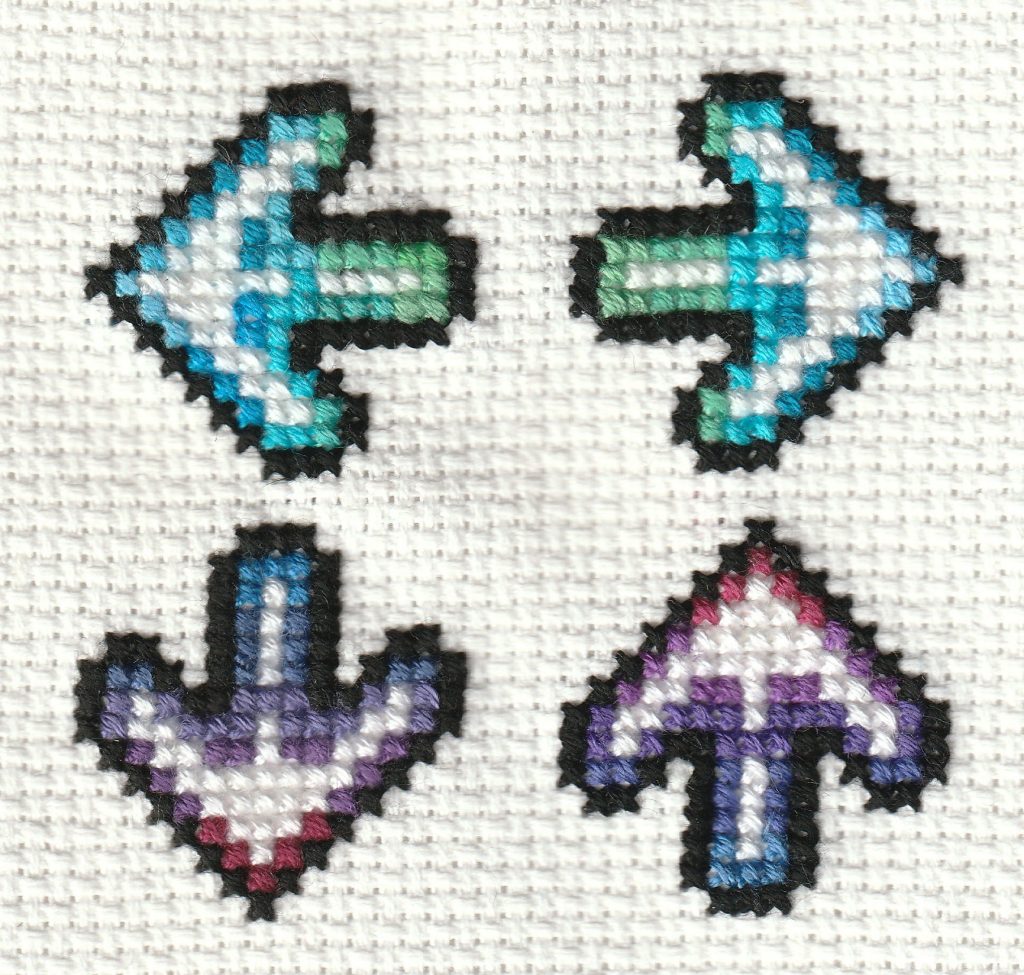
Boy that sure washes out the color saturation my camera picked up, but you can see the value difference a bit clearer.
Final thoughts
Honestly? CXC is a great deal for a ton of floss with only minimal downsides. If you’re a beginner just starting to fill out your collection this is a good way to get access to all the colors you’ll need for most projects.
If you’re dipping your toes into huge full coverage projects like a HAED, this is also a much cheaper way to purchase all your skeins at once to avoid having dye lot issues later on. Especially since these projects can take years to finish.
Will I be switching over to CXC? Yes and no. I’m still gonna use my DMC collection to pick colors for my designs and use DMC for my test stitching. Since DMC is still gonna be the most commonly used thread by those purchasing my patterns I want to make sure they’re as accurate as possible.
But for my own personal projects? I will absolutely be using CXC floss in the future.
Plus, it’s a great excuse to finally have a full set in color order while still keeping my DMC in number order. Just look how satisfying this is.
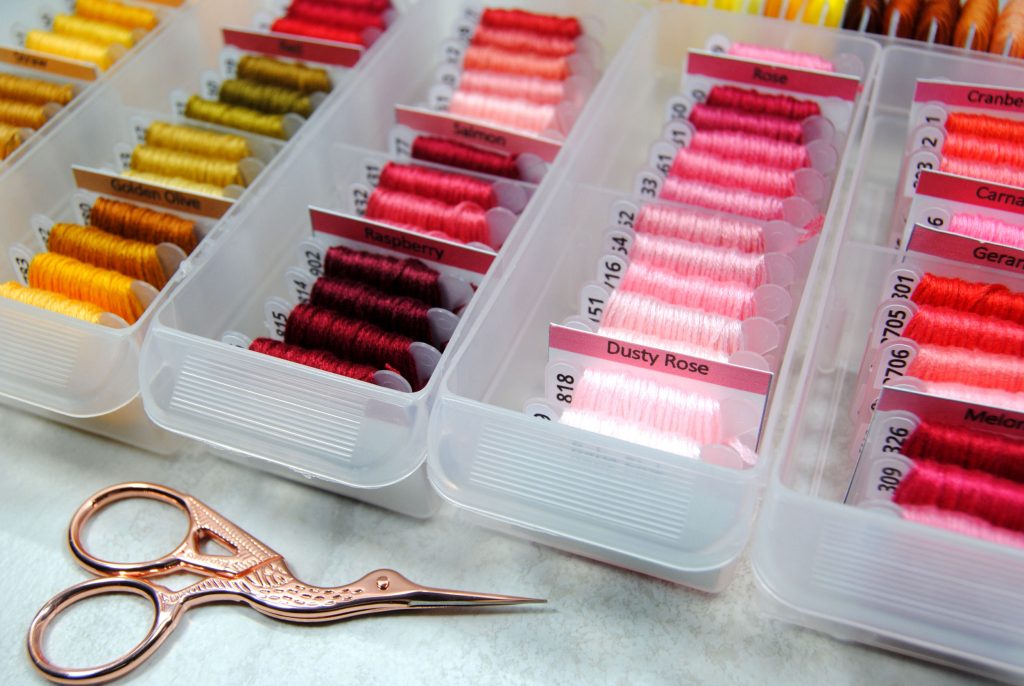
For the curious, I got clear bobbins from AliExpress, and I’ve labeled my bobbins with the CXC thread labels I sell on my Etsy. Then I sorted them by color using The Tidy Stitch organization system. Enjoy!

